Sagnik Majumder
Switch-a-View: Few-Shot View Selection Learned from Edited Videos
Dec 24, 2024Abstract:We introduce Switch-a-View, a model that learns to automatically select the viewpoint to display at each timepoint when creating a how-to video. The key insight of our approach is how to train such a model from unlabeled--but human-edited--video samples. We pose a pretext task that pseudo-labels segments in the training videos for their primary viewpoint (egocentric or exocentric), and then discovers the patterns between those view-switch moments on the one hand and the visual and spoken content in the how-to video on the other hand. Armed with this predictor, our model then takes an unseen multi-view video as input and orchestrates which viewpoint should be displayed when. We further introduce a few-shot training setting that permits steering the model towards a new data domain. We demonstrate our idea on a variety of real-world video from HowTo100M and Ego-Exo4D and rigorously validate its advantages.
Which Viewpoint Shows it Best? Language for Weakly Supervising View Selection in Multi-view Videos
Nov 13, 2024



Abstract:Given a multi-view video, which viewpoint is most informative for a human observer? Existing methods rely on heuristics or expensive ``best-view" supervision to answer this question, limiting their applicability. We propose a weakly supervised approach that leverages language accompanying an instructional multi-view video as a means to recover its most informative viewpoint(s). Our key hypothesis is that the more accurately an individual view can predict a view-agnostic text summary, the more informative it is. To put this into action, we propose a framework that uses the relative accuracy of view-dependent caption predictions as a proxy for best view pseudo-labels. Then, those pseudo-labels are used to train a view selector, together with an auxiliary camera pose predictor that enhances view-sensitivity. During inference, our model takes as input only a multi-view video -- no language or camera poses -- and returns the best viewpoint to watch at each timestep. On two challenging datasets comprised of diverse multi-camera setups and how-to activities, our model consistently outperforms state-of-the-art baselines, both with quantitative metrics and human evaluation.
ActiveRIR: Active Audio-Visual Exploration for Acoustic Environment Modeling
Apr 24, 2024



Abstract:An environment acoustic model represents how sound is transformed by the physical characteristics of an indoor environment, for any given source/receiver location. Traditional methods for constructing acoustic models involve expensive and time-consuming collection of large quantities of acoustic data at dense spatial locations in the space, or rely on privileged knowledge of scene geometry to intelligently select acoustic data sampling locations. We propose active acoustic sampling, a new task for efficiently building an environment acoustic model of an unmapped environment in which a mobile agent equipped with visual and acoustic sensors jointly constructs the environment acoustic model and the occupancy map on-the-fly. We introduce ActiveRIR, a reinforcement learning (RL) policy that leverages information from audio-visual sensor streams to guide agent navigation and determine optimal acoustic data sampling positions, yielding a high quality acoustic model of the environment from a minimal set of acoustic samples. We train our policy with a novel RL reward based on information gain in the environment acoustic model. Evaluating on diverse unseen indoor environments from a state-of-the-art acoustic simulation platform, ActiveRIR outperforms an array of methods--both traditional navigation agents based on spatial novelty and visual exploration as well as existing state-of-the-art methods.
Ego-Exo4D: Understanding Skilled Human Activity from First- and Third-Person Perspectives
Nov 30, 2023



Abstract:We present Ego-Exo4D, a diverse, large-scale multimodal multiview video dataset and benchmark challenge. Ego-Exo4D centers around simultaneously-captured egocentric and exocentric video of skilled human activities (e.g., sports, music, dance, bike repair). More than 800 participants from 13 cities worldwide performed these activities in 131 different natural scene contexts, yielding long-form captures from 1 to 42 minutes each and 1,422 hours of video combined. The multimodal nature of the dataset is unprecedented: the video is accompanied by multichannel audio, eye gaze, 3D point clouds, camera poses, IMU, and multiple paired language descriptions -- including a novel "expert commentary" done by coaches and teachers and tailored to the skilled-activity domain. To push the frontier of first-person video understanding of skilled human activity, we also present a suite of benchmark tasks and their annotations, including fine-grained activity understanding, proficiency estimation, cross-view translation, and 3D hand/body pose. All resources will be open sourced to fuel new research in the community.
Learning Spatial Features from Audio-Visual Correspondence in Egocentric Videos
Jul 10, 2023



Abstract:We propose a self-supervised method for learning representations based on spatial audio-visual correspondences in egocentric videos. In particular, our method leverages a masked auto-encoding framework to synthesize masked binaural audio through the synergy of audio and vision, thereby learning useful spatial relationships between the two modalities. We use our pretrained features to tackle two downstream video tasks requiring spatial understanding in social scenarios: active speaker detection and spatial audio denoising. We show through extensive experiments that our features are generic enough to improve over multiple state-of-the-art baselines on two public challenging egocentric video datasets, EgoCom and EasyCom. Project: http://vision.cs.utexas.edu/projects/ego_av_corr.
Chat2Map: Efficient Scene Mapping from Multi-Ego Conversations
Jan 04, 2023
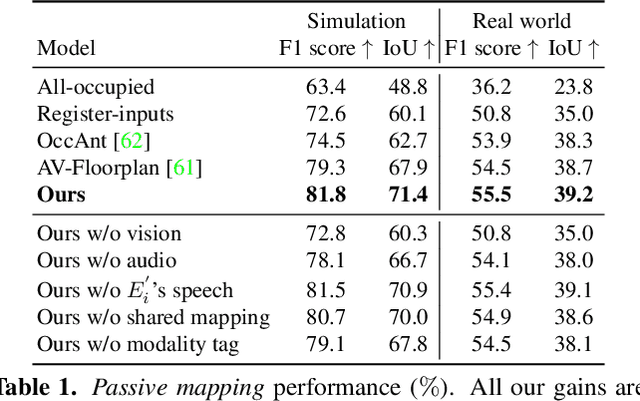

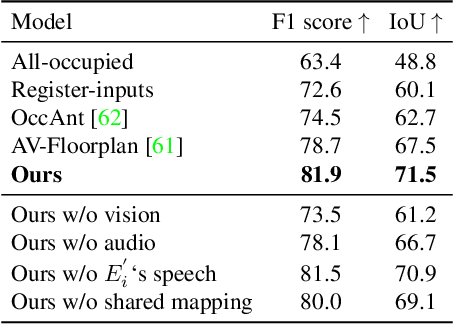
Abstract:Can conversational videos captured from multiple egocentric viewpoints reveal the map of a scene in a cost-efficient way? We seek to answer this question by proposing a new problem: efficiently building the map of a previously unseen 3D environment by exploiting shared information in the egocentric audio-visual observations of participants in a natural conversation. Our hypothesis is that as multiple people ("egos") move in a scene and talk among themselves, they receive rich audio-visual cues that can help uncover the unseen areas of the scene. Given the high cost of continuously processing egocentric visual streams, we further explore how to actively coordinate the sampling of visual information, so as to minimize redundancy and reduce power use. To that end, we present an audio-visual deep reinforcement learning approach that works with our shared scene mapper to selectively turn on the camera to efficiently chart out the space. We evaluate the approach using a state-of-the-art audio-visual simulator for 3D scenes as well as real-world video. Our model outperforms previous state-of-the-art mapping methods, and achieves an excellent cost-accuracy tradeoff. Project: http://vision.cs.utexas.edu/projects/chat2map.
Retrospectives on the Embodied AI Workshop
Oct 17, 2022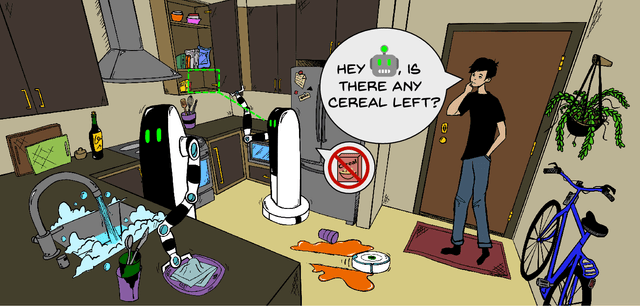

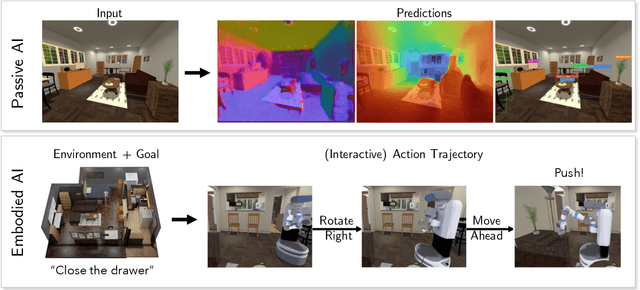
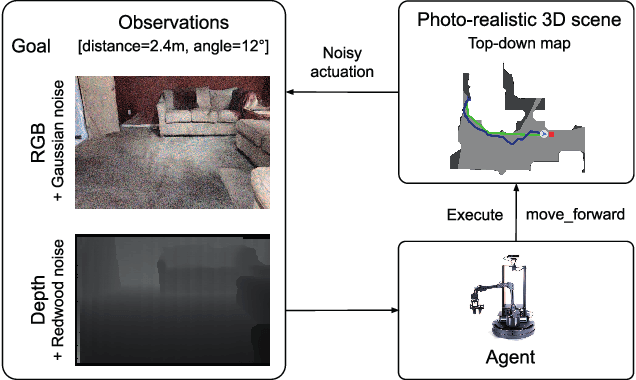
Abstract:We present a retrospective on the state of Embodied AI research. Our analysis focuses on 13 challenges presented at the Embodied AI Workshop at CVPR. These challenges are grouped into three themes: (1) visual navigation, (2) rearrangement, and (3) embodied vision-and-language. We discuss the dominant datasets within each theme, evaluation metrics for the challenges, and the performance of state-of-the-art models. We highlight commonalities between top approaches to the challenges and identify potential future directions for Embodied AI research.
Few-Shot Audio-Visual Learning of Environment Acoustics
Jun 08, 2022
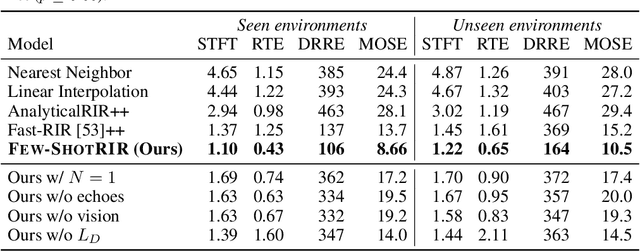
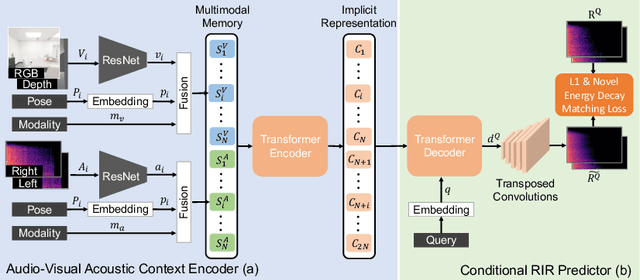

Abstract:Room impulse response (RIR) functions capture how the surrounding physical environment transforms the sounds heard by a listener, with implications for various applications in AR, VR, and robotics. Whereas traditional methods to estimate RIRs assume dense geometry and/or sound measurements throughout the environment, we explore how to infer RIRs based on a sparse set of images and echoes observed in the space. Towards that goal, we introduce a transformer-based method that uses self-attention to build a rich acoustic context, then predicts RIRs of arbitrary query source-receiver locations through cross-attention. Additionally, we design a novel training objective that improves the match in the acoustic signature between the RIR predictions and the targets. In experiments using a state-of-the-art audio-visual simulator for 3D environments, we demonstrate that our method successfully generates arbitrary RIRs, outperforming state-of-the-art methods and--in a major departure from traditional methods--generalizing to novel environments in a few-shot manner. Project: http://vision.cs.utexas.edu/projects/fs_rir.
Active Audio-Visual Separation of Dynamic Sound Sources
Feb 02, 2022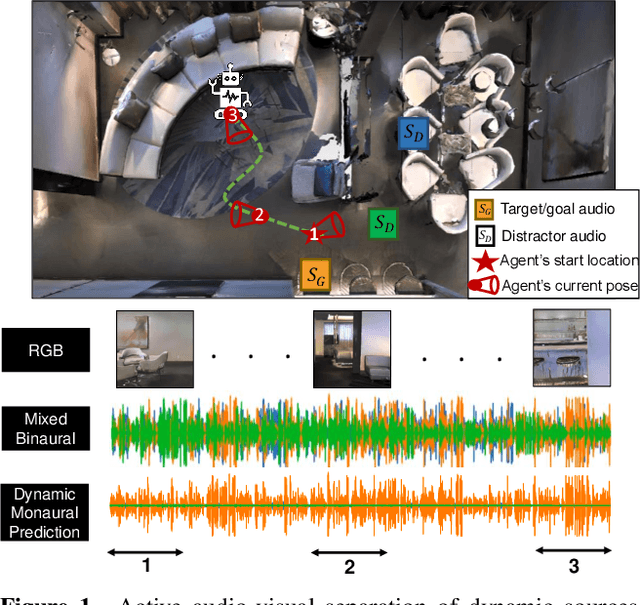
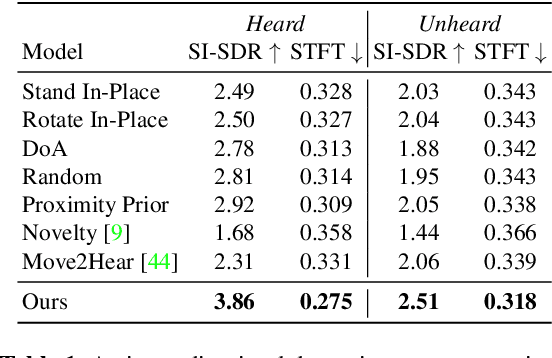
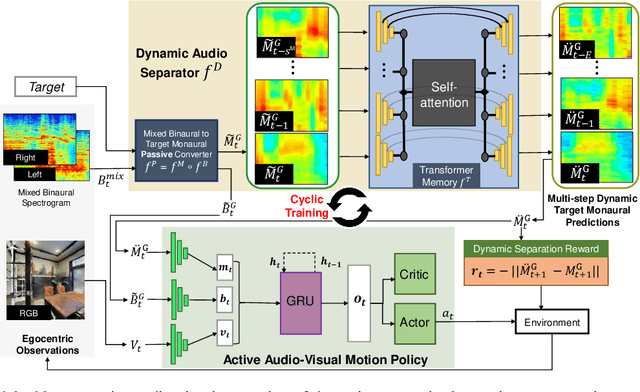
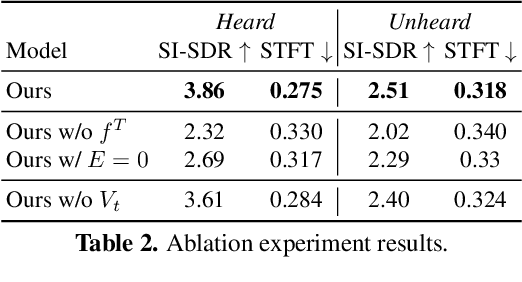
Abstract:We explore active audio-visual separation for dynamic sound sources, where an embodied agent moves intelligently in a 3D environment to continuously isolate the time-varying audio stream being emitted by an object of interest. The agent hears a mixed stream of multiple time-varying audio sources (e.g., multiple people conversing and a band playing music at a noisy party). Given a limited time budget, it needs to extract the target sound using egocentric audio-visual observations. We propose a reinforcement learning agent equipped with a novel transformer memory that learns motion policies to control its camera and microphone to recover the dynamic target audio, improving its own estimates for past timesteps via self-attention. Using highly realistic acoustic SoundSpaces simulations in real-world scanned Matterport3D environments, we show that our model is able to learn efficient behavior to carry out continuous separation of a time-varying audio target. Project: https://vision.cs.utexas.edu/projects/active-av-dynamic-separation/.
Move2Hear: Active Audio-Visual Source Separation
May 15, 2021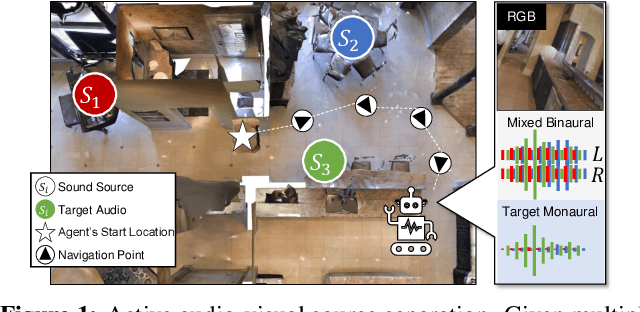
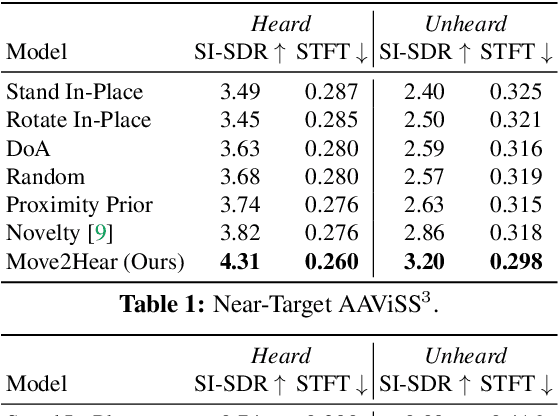
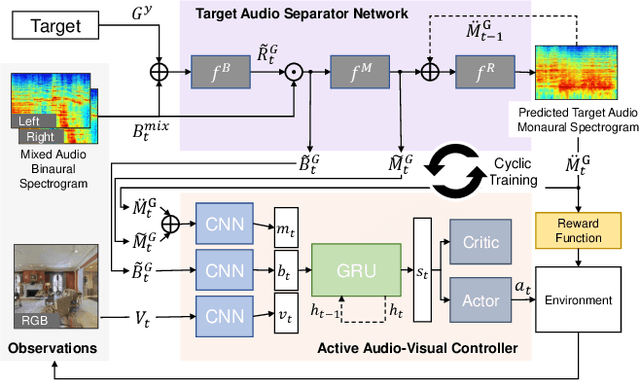
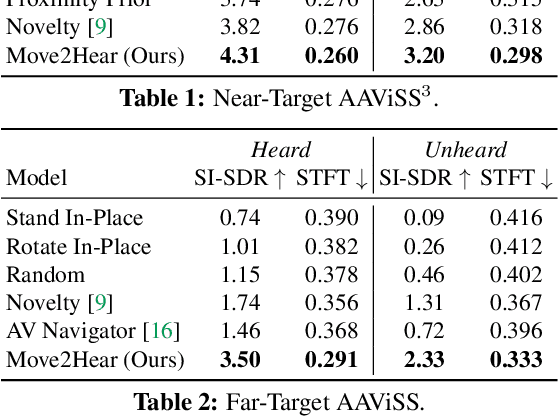
Abstract:We introduce the active audio-visual source separation problem, where an agent must move intelligently in order to better isolate the sounds coming from an object of interest in its environment. The agent hears multiple audio sources simultaneously (e.g., a person speaking down the hall in a noisy household) and must use its eyes and ears to automatically separate out the sounds originating from the target object within a limited time budget. Towards this goal, we introduce a reinforcement learning approach that trains movement policies controlling the agent's camera and microphone placement over time, guided by the improvement in predicted audio separation quality. We demonstrate our approach in scenarios motivated by both augmented reality (system is already co-located with the target object) and mobile robotics (agent begins arbitrarily far from the target object). Using state-of-the-art realistic audio-visual simulations in 3D environments, we demonstrate our model's ability to find minimal movement sequences with maximal payoff for audio source separation. Project: http://vision.cs.utexas.edu/projects/move2hear.
 Add to Chrome
Add to Chrome Add to Firefox
Add to Firefox Add to Edge
Add to Edge